Social equity in current context of scientific technological revolution in Vietnam
Vietnam has made great achievements in implementing social equity. However, the level
of social equity in the country is still not yet as expected, while the rich-poor gap keeps widening.
In the next ten years, when the achievements of the scientific-technical revolution as well as the
scientific-technological revolution, Industrial Revolution 3.0 and Industrial Revolution 4.0 are
brought to Vietnam more and more, their impacts on Vietnam will be stronger. On the one hand,
they contribute to ensuring social equity on a more solid, broader and deeper foundation. On the
other hand, social equity on the vertical dimension is accelerated by the scientific-technological
revolution creating a more reasonable rich-poor gap. However, in order to achieve that, it is
necessary to promote the maximised and effective use of the achievements of the scientifictechnological revolution to narrow the gap between the rich and the poor. To properly take
advantage of the scientific-technological revolution for humanitarian goals and social progress has
become an urgent task and requirement of the modern society.
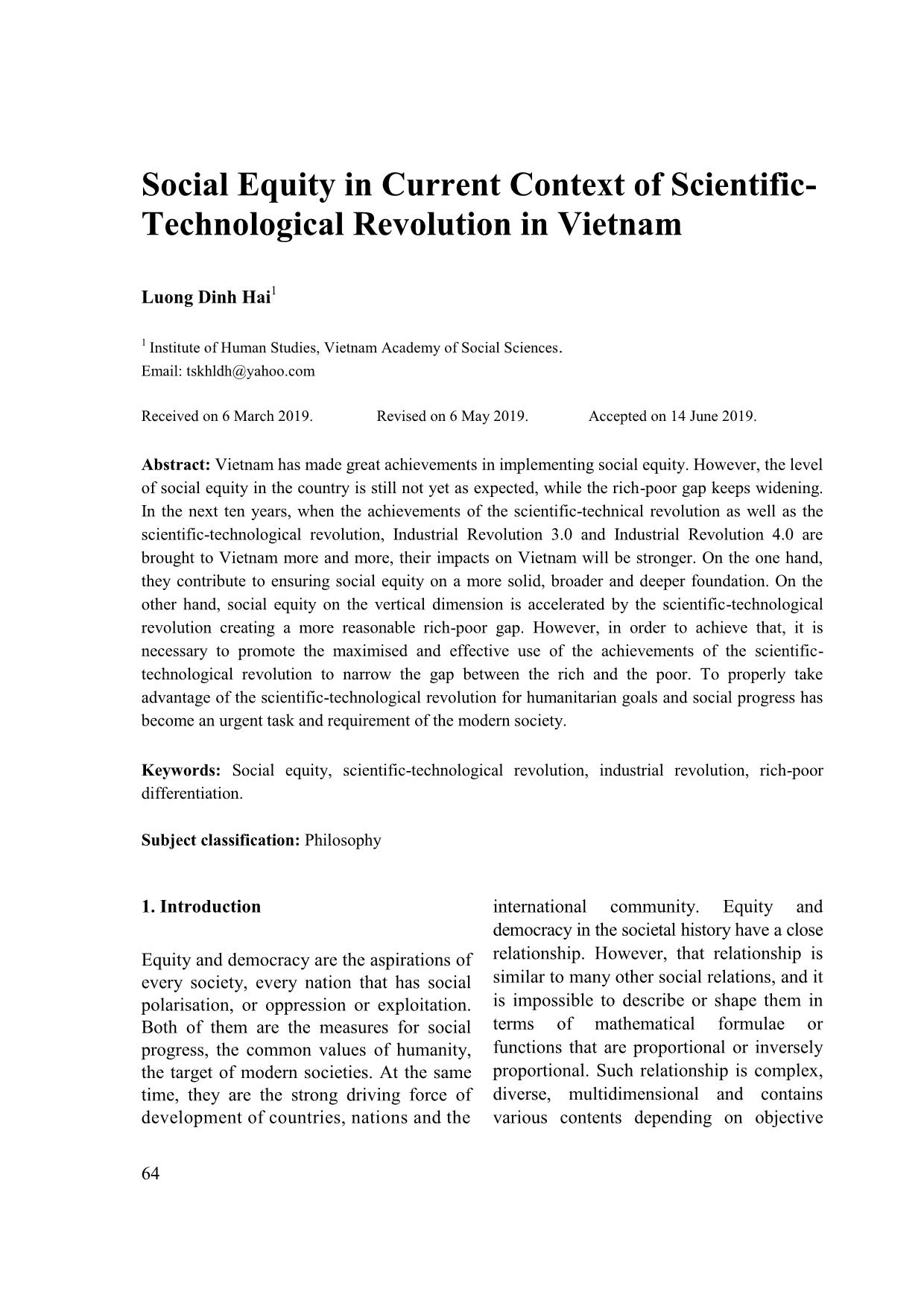
Trang 1
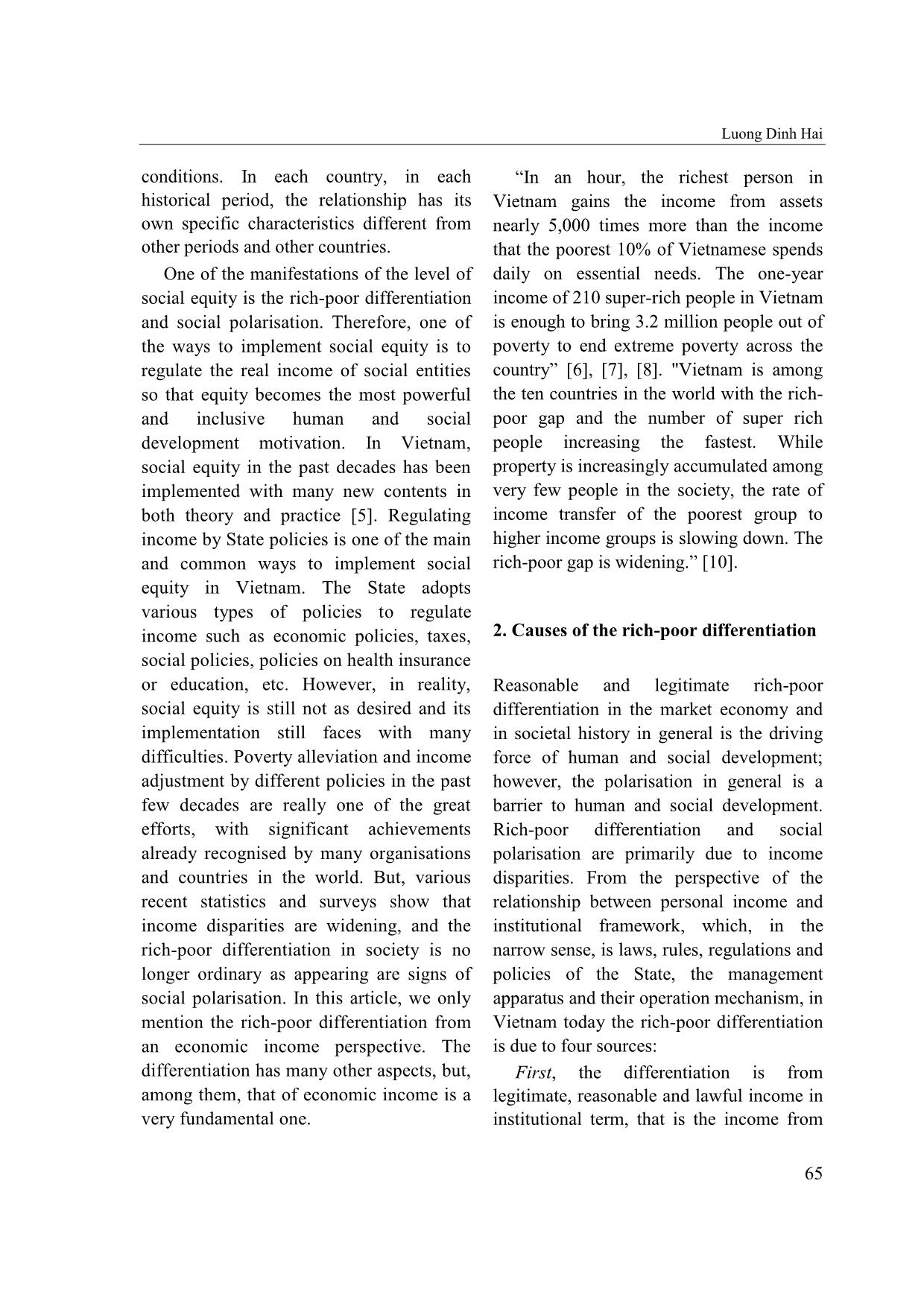
Trang 2
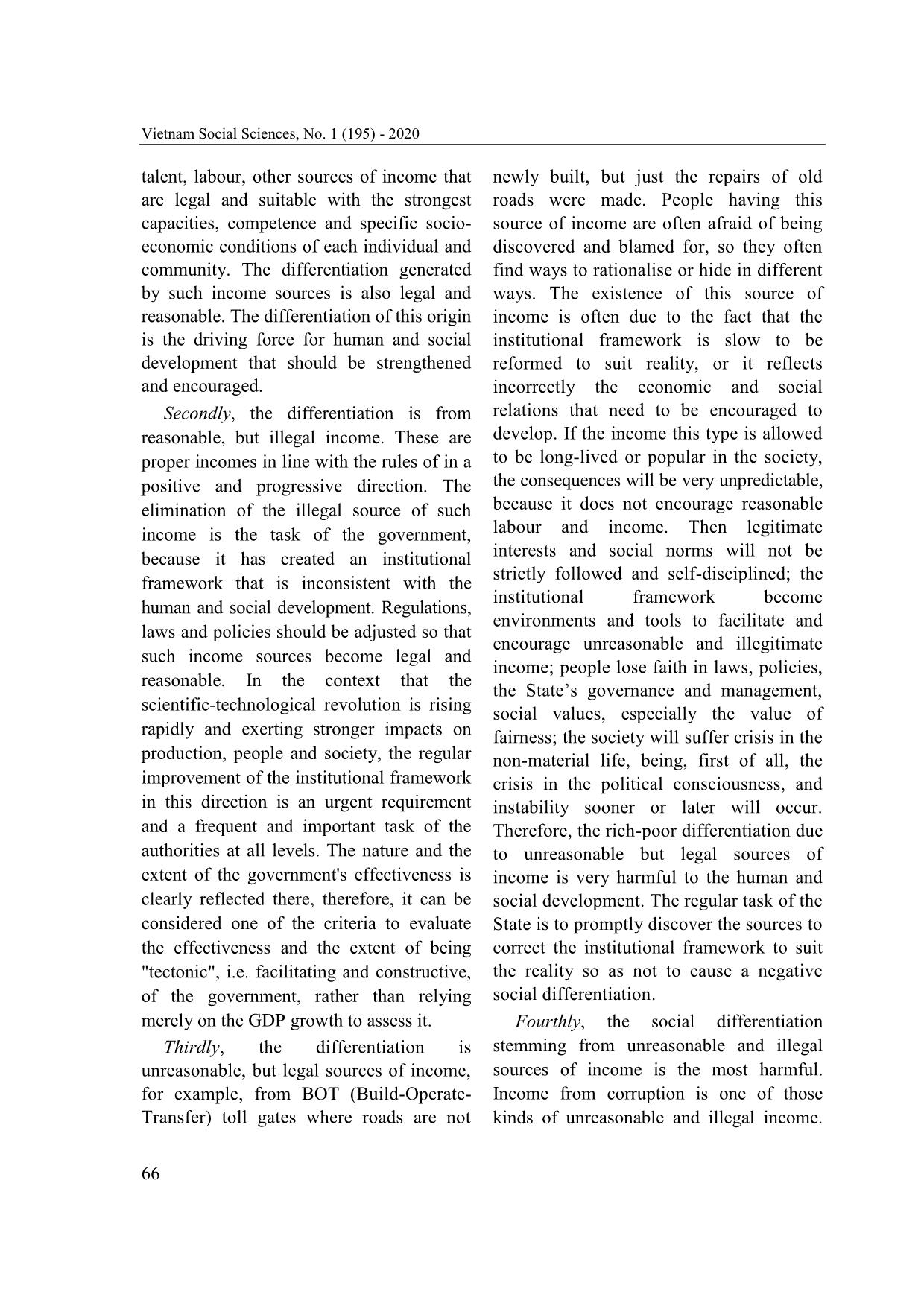
Trang 3
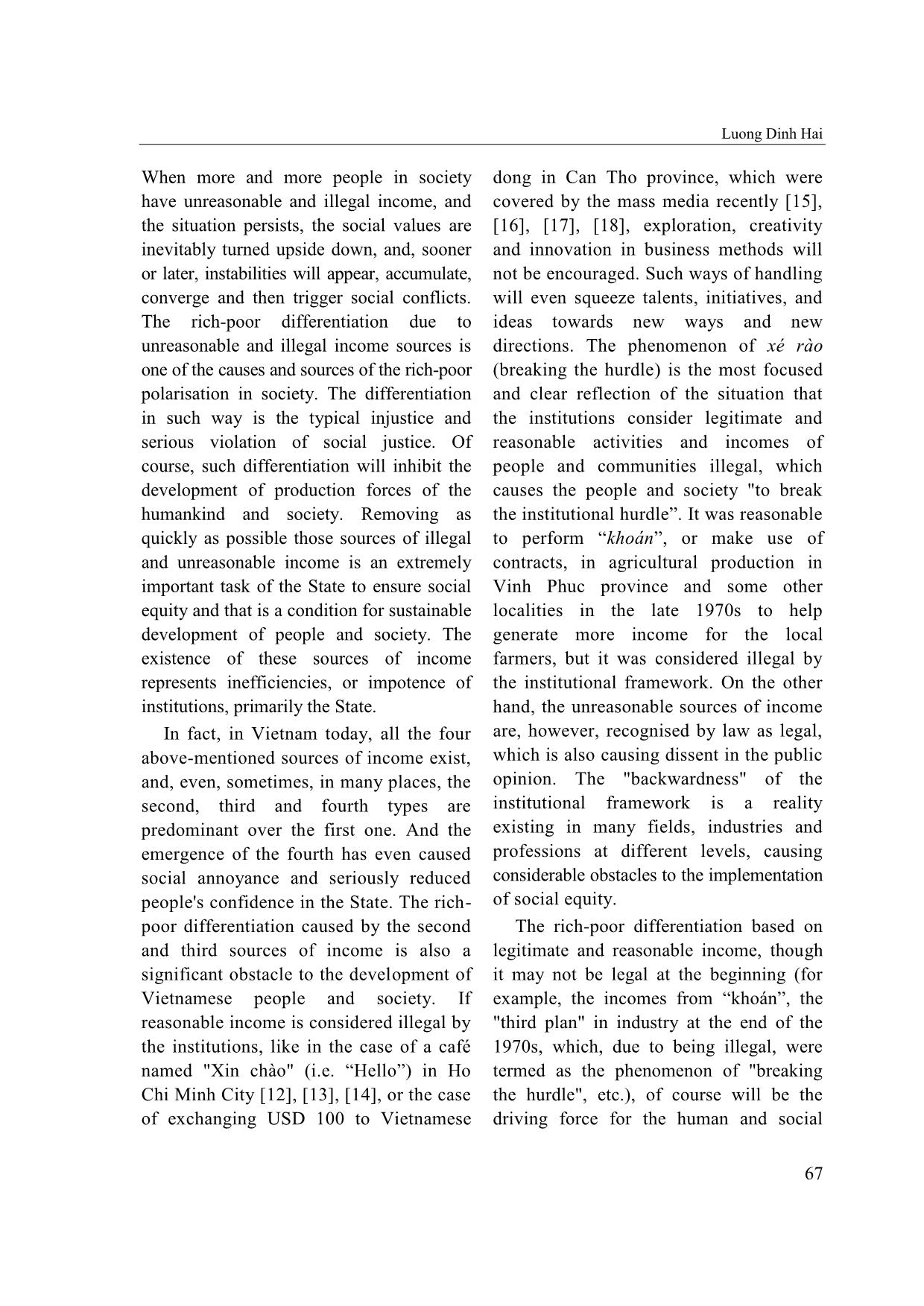
Trang 4
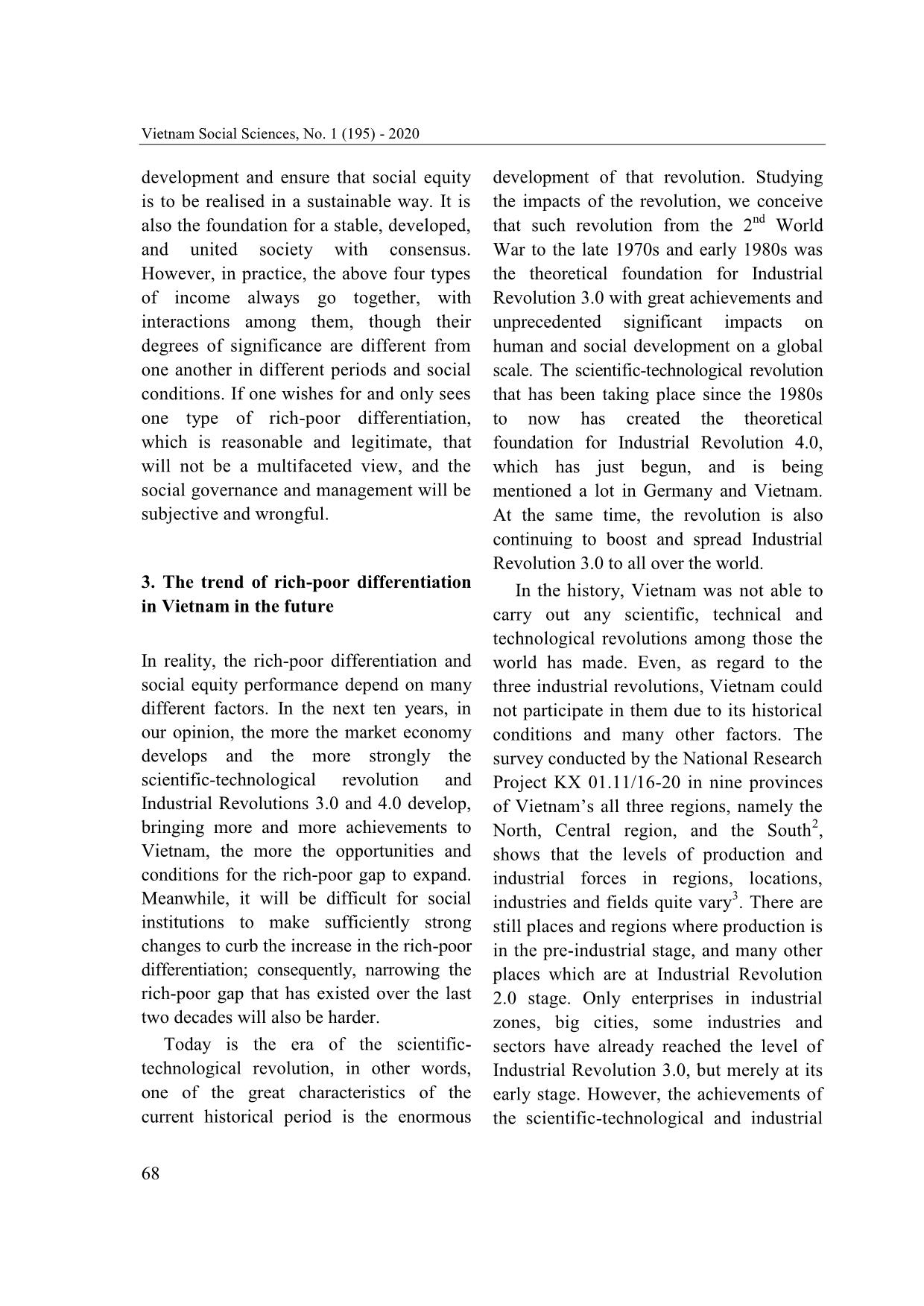
Trang 5
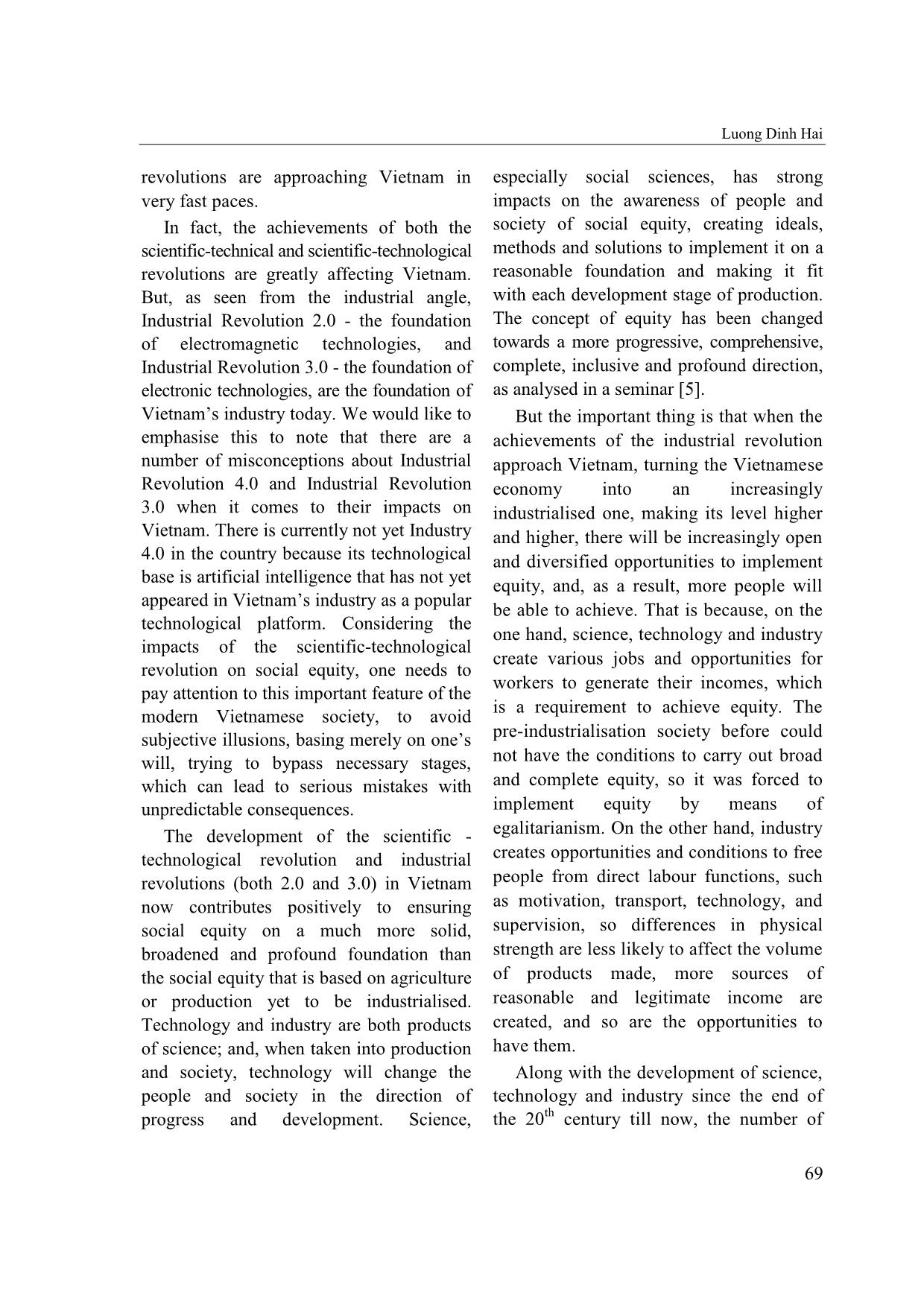
Trang 6
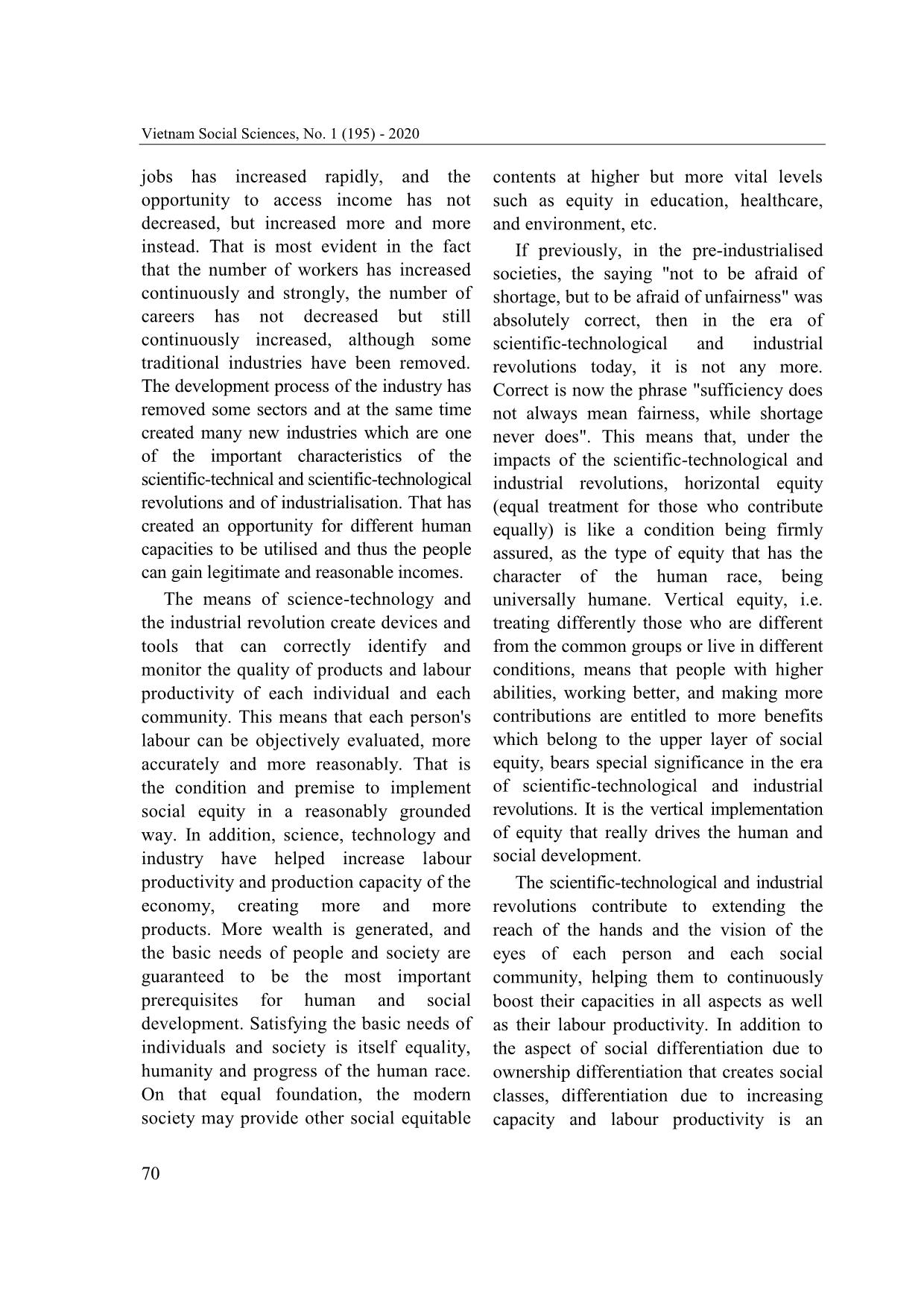
Trang 7
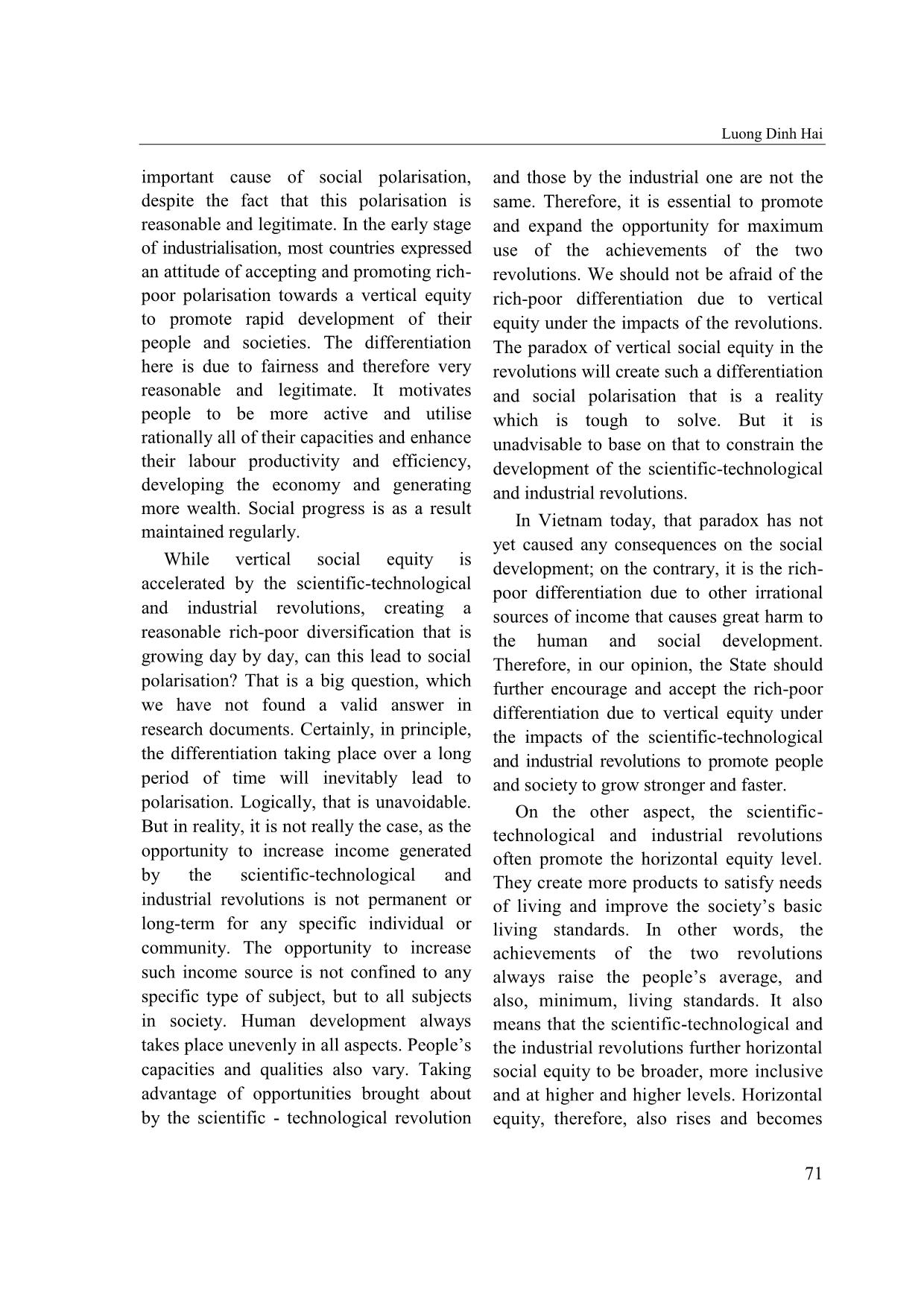
Trang 8
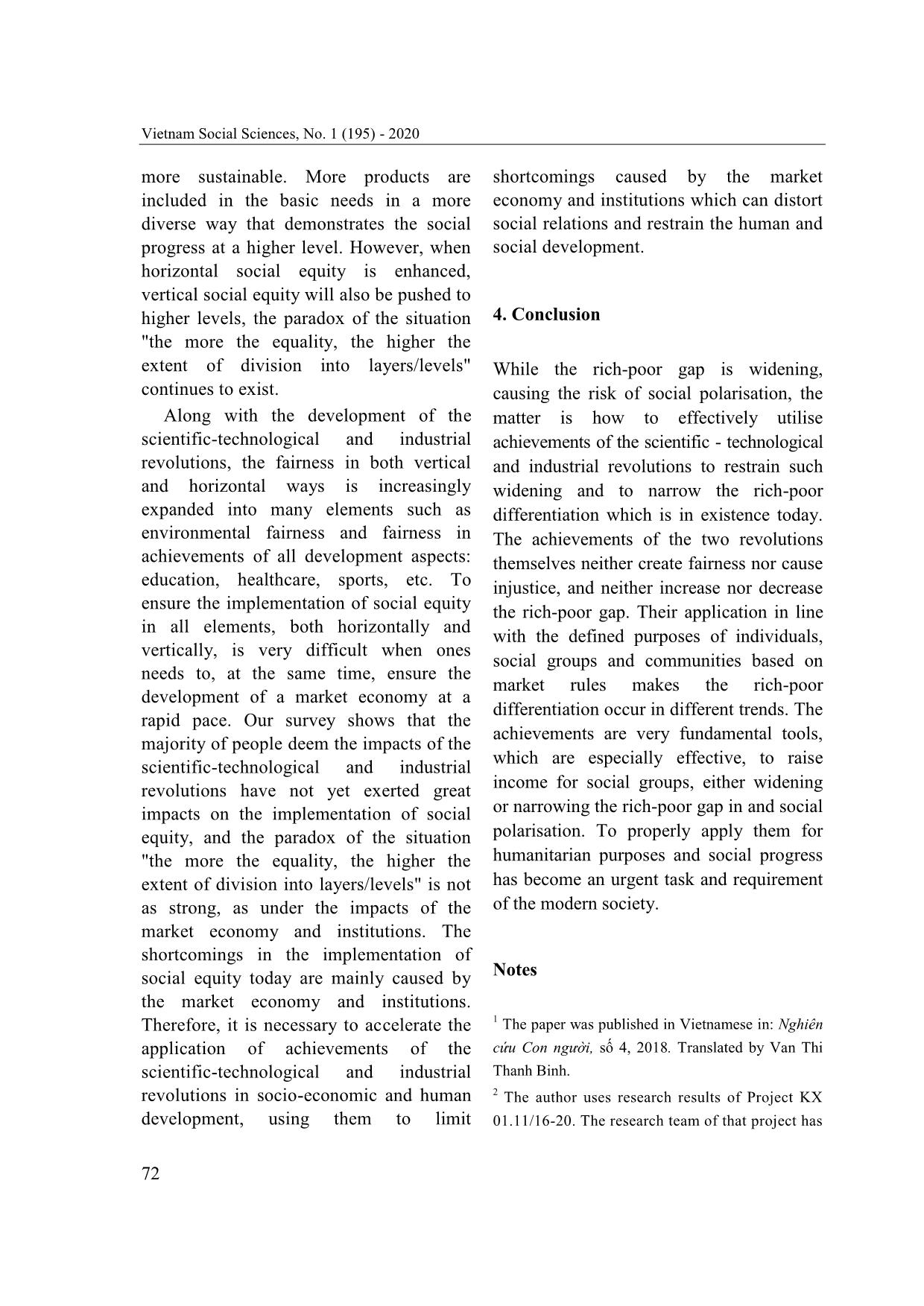
Trang 9
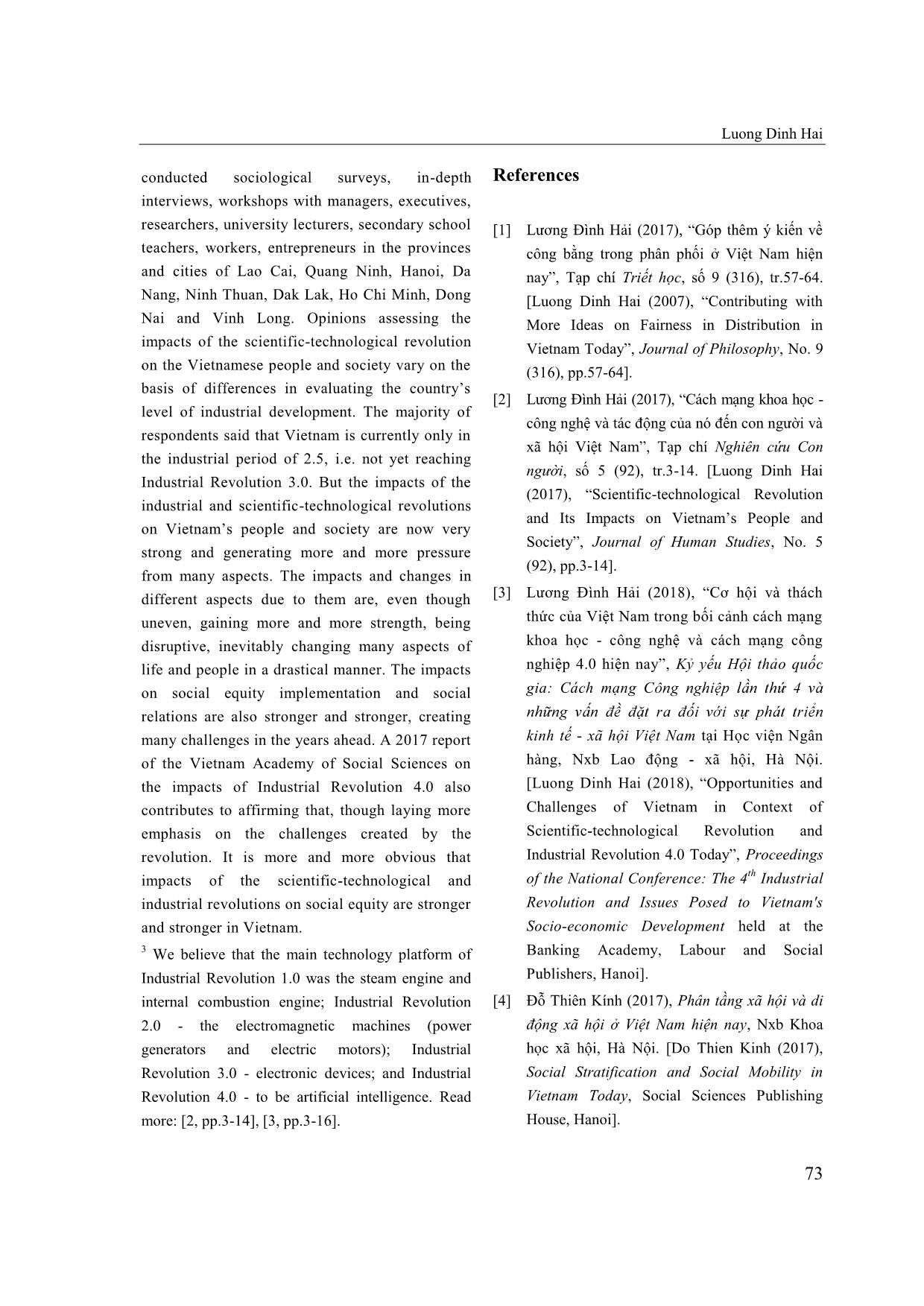
Trang 10
Tải về để xem bản đầy đủ
Tóm tắt nội dung tài liệu: Social equity in current context of scientific technological revolution in Vietnam
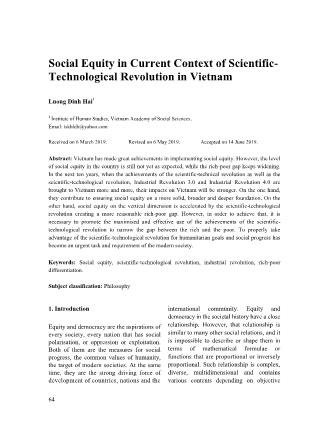
dustrial revolution create devices and tools that can correctly identify and monitor the quality of products and labour productivity of each individual and each community. This means that each person's labour can be objectively evaluated, more accurately and more reasonably. That is the condition and premise to implement social equity in a reasonably grounded way. In addition, science, technology and industry have helped increase labour productivity and production capacity of the economy, creating more and more products. More wealth is generated, and the basic needs of people and society are guaranteed to be the most important prerequisites for human and social development. Satisfying the basic needs of individuals and society is itself equality, humanity and progress of the human race. On that equal foundation, the modern society may provide other social equitable contents at higher but more vital levels such as equity in education, healthcare, and environment, etc. If previously, in the pre-industrialised societies, the saying "not to be afraid of shortage, but to be afraid of unfairness" was absolutely correct, then in the era of scientific-technological and industrial revolutions today, it is not any more. Correct is now the phrase "sufficiency does not always mean fairness, while shortage never does". This means that, under the impacts of the scientific-technological and industrial revolutions, horizontal equity (equal treatment for those who contribute equally) is like a condition being firmly assured, as the type of equity that has the character of the human race, being universally humane. Vertical equity, i.e. treating differently those who are different from the common groups or live in different conditions, means that people with higher abilities, working better, and making more contributions are entitled to more benefits which belong to the upper layer of social equity, bears special significance in the era of scientific-technological and industrial revolutions. It is the vertical implementation of equity that really drives the human and social development. The scientific-technological and industrial revolutions contribute to extending the reach of the hands and the vision of the eyes of each person and each social community, helping them to continuously boost their capacities in all aspects as well as their labour productivity. In addition to the aspect of social differentiation due to ownership differentiation that creates social classes, differentiation due to increasing capacity and labour productivity is an Luong Dinh Hai 71 important cause of social polarisation, despite the fact that this polarisation is reasonable and legitimate. In the early stage of industrialisation, most countries expressed an attitude of accepting and promoting rich- poor polarisation towards a vertical equity to promote rapid development of their people and societies. The differentiation here is due to fairness and therefore very reasonable and legitimate. It motivates people to be more active and utilise rationally all of their capacities and enhance their labour productivity and efficiency, developing the economy and generating more wealth. Social progress is as a result maintained regularly. While vertical social equity is accelerated by the scientific-technological and industrial revolutions, creating a reasonable rich-poor diversification that is growing day by day, can this lead to social polarisation? That is a big question, which we have not found a valid answer in research documents. Certainly, in principle, the differentiation taking place over a long period of time will inevitably lead to polarisation. Logically, that is unavoidable. But in reality, it is not really the case, as the opportunity to increase income generated by the scientific-technological and industrial revolutions is not permanent or long-term for any specific individual or community. The opportunity to increase such income source is not confined to any specific type of subject, but to all subjects in society. Human development always takes place unevenly in all aspects. People’s capacities and qualities also vary. Taking advantage of opportunities brought about by the scientific - technological revolution and those by the industrial one are not the same. Therefore, it is essential to promote and expand the opportunity for maximum use of the achievements of the two revolutions. We should not be afraid of the rich-poor differentiation due to vertical equity under the impacts of the revolutions. The paradox of vertical social equity in the revolutions will create such a differentiation and social polarisation that is a reality which is tough to solve. But it is unadvisable to base on that to constrain the development of the scientific-technological and industrial revolutions. In Vietnam today, that paradox has not yet caused any consequences on the social development; on the contrary, it is the rich- poor differentiation due to other irrational sources of income that causes great harm to the human and social development. Therefore, in our opinion, the State should further encourage and accept the rich-poor differentiation due to vertical equity under the impacts of the scientific-technological and industrial revolutions to promote people and society to grow stronger and faster. On the other aspect, the scientific- technological and industrial revolutions often promote the horizontal equity level. They create more products to satisfy needs of living and improve the society’s basic living standards. In other words, the achievements of the two revolutions always raise the people’s average, and also, minimum, living standards. It also means that the scientific-technological and the industrial revolutions further horizontal social equity to be broader, more inclusive and at higher and higher levels. Horizontal equity, therefore, also rises and becomes Vietnam Social Sciences, No. 1 (195) - 2020 72 more sustainable. More products are included in the basic needs in a more diverse way that demonstrates the social progress at a higher level. However, when horizontal social equity is enhanced, vertical social equity will also be pushed to higher levels, the paradox of the situation "the more the equality, the higher the extent of division into layers/levels" continues to exist. Along with the development of the scientific-technological and industrial revolutions, the fairness in both vertical and horizontal ways is increasingly expanded into many elements such as environmental fairness and fairness in achievements of all development aspects: education, healthcare, sports, etc. To ensure the implementation of social equity in all elements, both horizontally and vertically, is very difficult when ones needs to, at the same time, ensure the development of a market economy at a rapid pace. Our survey shows that the majority of people deem the impacts of the scientific-technological and industrial revolutions have not yet exerted great impacts on the implementation of social equity, and the paradox of the situation "the more the equality, the higher the extent of division into layers/levels" is not as strong, as under the impacts of the market economy and institutions. The shortcomings in the implementation of social equity today are mainly caused by the market economy and institutions. Therefore, it is necessary to accelerate the application of achievements of the scientific-technological and industrial revolutions in socio-economic and human development, using them to limit shortcomings caused by the market economy and institutions which can distort social relations and restrain the human and social development. 4. Conclusion While the rich-poor gap is widening, causing the risk of social polarisation, the matter is how to effectively utilise achievements of the scientific - technological and industrial revolutions to restrain such widening and to narrow the rich-poor differentiation which is in existence today. The achievements of the two revolutions themselves neither create fairness nor cause injustice, and neither increase nor decrease the rich-poor gap. Their application in line with the defined purposes of individuals, social groups and communities based on market rules makes the rich-poor differentiation occur in different trends. The achievements are very fundamental tools, which are especially effective, to raise income for social groups, either widening or narrowing the rich-poor gap in and social polarisation. To properly apply them for humanitarian purposes and social progress has become an urgent task and requirement of the modern society. Notes 1 The paper was published in Vietnamese in: Nghiên cứu Con người, số 4, 2018. Translated by Van Thi Thanh Binh. 2 The author uses research results of Project KX 01.11/16-20. The research team of that project has Luong Dinh Hai 73 conducted sociological surveys, in-depth interviews, workshops with managers, executives, researchers, university lecturers, secondary school teachers, workers, entrepreneurs in the provinces and cities of Lao Cai, Quang Ninh, Hanoi, Da Nang, Ninh Thuan, Dak Lak, Ho Chi Minh, Dong Nai and Vinh Long. Opinions assessing the impacts of the scientific-technological revolution on the Vietnamese people and society vary on the basis of differences in evaluating the country’s level of industrial development. The majority of respondents said that Vietnam is currently only in the industrial period of 2.5, i.e. not yet reaching Industrial Revolution 3.0. But the impacts of the industrial and scientific-technological revolutions on Vietnam’s people and society are now very strong and generating more and more pressure from many aspects. The impacts and changes in different aspects due to them are, even though uneven, gaining more and more strength, being disruptive, inevitably changing many aspects of life and people in a drastical manner. The impacts on social equity implementation and social relations are also stronger and stronger, creating many challenges in the years ahead. A 2017 report of the Vietnam Academy of Social Sciences on the impacts of Industrial Revolution 4.0 also contributes to affirming that, though laying more emphasis on the challenges created by the revolution. It is more and more obvious that impacts of the scientific-technological and industrial revolutions on social equity are stronger and stronger in Vietnam. 3 We believe that the main technology platform of Industrial Revolution 1.0 was the steam engine and internal combustion engine; Industrial Revolution 2.0 - the electromagnetic machines (power generators and electric motors); Industrial Revolution 3.0 - electronic devices; and Industrial Revolution 4.0 - to be artificial intelligence. Read more: [2, pp.3-14], [3, pp.3-16]. References [1] Lương Đình Hải (2017), “Góp thêm ý kiến về công bằng trong phân phối ở Việt Nam hiện nay”, Tạp chí Triết học, số 9 (316), tr.57-64. [Luong Dinh Hai (2007), “Contributing with More Ideas on Fairness in Distribution in Vietnam Today”, Journal of Philosophy, No. 9 (316), pp.57-64]. [2] Lương Đình Hải (2017), “Cách mạng khoa học - công nghệ và tác động của nó đến con người và xã hội Việt Nam”, Tạp chí Nghiên cứu Con người, số 5 (92), tr.3-14. [Luong Dinh Hai (2017), “Scientific-technological Revolution and Its Impacts on Vietnam’s People and Society”, Journal of Human Studies, No. 5 (92), pp.3-14]. [3] Lương Đình Hải (2018), “Cơ hội và thách thức của Việt Nam trong bối cảnh cách mạng khoa học - công nghệ và cách mạng công nghiệp 4.0 hiện nay”, Kỷ yếu Hội thảo quốc gia: Cách mạng C kinh tế - xã hội Việt Nam tại Học viện Ngân hàng, Nxb Lao động - xã hội, Hà Nội. [Luong Dinh Hai (2018), “Opportunities and Challenges of Vietnam in Context of Scientific-technological Revolution and Industrial Revolution 4.0 Today”, Proceedings of the National Conference: The 4 th Industrial Revolution and Issues Posed to Vietnam's Socio-economic Development held at the Banking Academy, Labour and Social Publishers, Hanoi]. [4] Đỗ Thiên Kính (2017), Phân tầng xã hội và di động xã hội ở Việt Nam hiện nay, Nxb Khoa học xã hội, Hà Nội. [Do Thien Kinh (2017), Social Stratification and Social Mobility in Vietnam Today, Social Sciences Publishing House, Hanoi]. Vietnam Social Sciences, No. 1 (195) - 2020 74 [5] Viện Triết học, Quỹ FES và Quỹ Rosa Luxemburg (2017), Kỷ yếu Hội thảo khoa học quốc tế: Tư tưởng của C. Mác về công bằng phân phối và ý nghĩa hiện thời của nó, Buôn Ma Thuột. [Institute of Philosophy, Friedrich Ebert- Stiftung and Rosa Luxemburg Stiftung (2017), Proceedings of the International Conference: K.Marx's Thought on Fairness in Distribution and Its Meanings Today, Buon Ma Thuot]. [6] 2017-01-12/chenh-lech-thu-nhap-ngay-cang-gia- tang-39855.aspx, retrieved on 12 January 2017. [7] cach-giau-ngheo-o-viet-nam-dang-gia-tang-manh- 664e1f4f.aspx, retrieved on 12 January 2017. [8] luan/Thuc-trang-chenh-lech-giau-ngheo-o-Viet- Nam-49959.html, retrieved on 25 September 2013. [9] https://vietnam.oxfam.org/press_release/oxfam- - - - - - - - - - -nam- -khởi-động-chiến-dịch-thu-hẹp, retrieved on 12 January 2017. [10] cach-giau-ngheo-mong-manh-thu-nhap-truc- dien-nghich-canh-438709.html, retrieved on 12 April 2017. [12] https://news.zing.vn/vu-ca-phe-xin-chao-cach- chuc-truong-cong-an-binh-chanh-post675901. html, retrieved on 27 April 2019. [13] https://vnexpress.net/phap-luat/sau-vu-quan-ca- phe-xin-chao-chu-doanh-nghiep-duoc-tuyen-vo- toi-3539759.html, retrieved on 27 April 2019. [14] https://baomoi.com/gap-lai-chu-quan-cafe-xin- chao-den-chet-van-khong-quen-phut-xuc-dong- duoc-minh-oan/c/24965484.epi, retrieved on 27 April 2019. [15] https://baomoi.com/vu-doi-100-usd-bi-phat-o- can-tho-tra-lai-tang-vat-100-usd-mien-tien-phat/ c/28349528.epi, retrieved on 27 April 2019. [16] https://www.24h.com.vn/tin-tuc-trong-ngay/vu- doi-100-usd-bi-phat-90-trieu-o-can-tho-lam-nong- quoc-hoi-c46a1001294.html, retrieved on 27 April 2019. [17] https://thanhnien.vn/thoi-su/vu-doi-100-usd-phat- 90-trieu-20-vien-kim-cuong-quay-ve-tiem-vang- thao-luc-1021827.html, retrieved on 27 April 2019. [18] https://hanoimoi.com.vn/tin-tuc/Xa-hoi/918185 /vu-doi-100-usd-o-can-tho-huy-mot-phan-xu-phat- tiem-vang-thao-luc, retrieved on 27 April 2019.
File đính kèm:
 social_equity_in_current_context_of_scientific_technological.pdf
social_equity_in_current_context_of_scientific_technological.pdf

